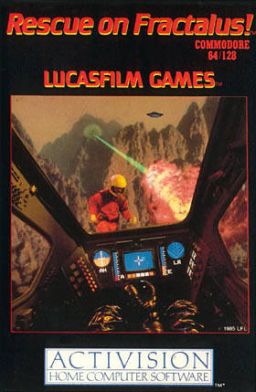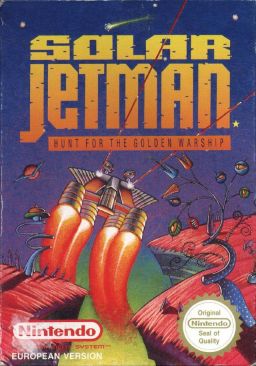
Rescue On Fractalus! is a space combat simulator video game created by Lucasfilm Games. It was originally released in 1985 for the Atari 8-bit computers and Atari 5200 console, then ported to the Apple II, ZX Spectrum, Amstrad CPC, Tandy Color Computer 3, and Commodore 64. The player flies a space fighter near the surface of a planet, with the goal of rescuing downed pilots. The terrain is generated via fractals, from which the eponymous planet and game title are taken.

Silent Service is a submarine simulator video game designed by Sid Meier and published by MicroProse for various 8-bit home computers in 1985 and for 16-bit systems like the Amiga in 1987. A Nintendo Entertainment System version developed by Rare was published in 1989 by Konami in Europe and by Konami's Ultra Games subsidiary in North America. Silent Service II was released in 1990. Tommo purchased the rights to this game and published it online through its Retroism brand in 2015.

Mindscape was a video game developer and publisher. The company was founded by Roger Buoy in October 1983 in Northbrook, Illinois, originally as part of SFN Companies until a management buyout was completed in 1987. Mindscape went public in 1988 and was subsequently acquired in 1990 by The Software Toolworks, eyeing Mindscape's Nintendo license. When Toolworks was acquired by Pearson plc in 1994, Mindscape became the primary identity for the development group. Mindscape was then sold to The Learning Company in 1998 and bought out by Jean-Pierre Nordman in 2001, becoming headquartered in Boulogne-Billancourt, France. Following the poor performance of its products, Mindscape exited the video game industry in August 2011. Notable titles released by Mindscape include the MacVenture series, Balance of Power, Moonstone: A Hard Days Knight, Legend, Warhammer: Shadow of the Horned Rat, Warhammer: Dark Omen and Lego Island.

Solar Jetman: Hunt for the Golden Warpship is a multi-directional shooter video game developed by Zippo Games and Rare and published by Tradewest in North America and by Nintendo in Europe. It was released in North America on 14 October 1990 and in Europe on 26 September 1991 for the Nintendo Entertainment System. The game is the third installment of the Jetman series and was later re-released by Nintendo for their NES-based PlayChoice-10 arcade system in the United States in 1990.

Paperboy is an arcade action game developed and published by Atari Games, and released in 1985. The player takes the role of a paperboy who delivers a fictional newspaper called The Daily Sun along a street on his bicycle. The arcade version of the game featured bike handlebars as the controller.

F-19 Stealth Fighter is a combat flight simulator developed and released in 1988 and 1990 by MicroProse, featuring a fictional United States military aircraft. It is the 16-bit remake of the 8-bit game Project Stealth Fighter, which was released for the Commodore 64 in 1987. It was also ported to the NEC PC-9801 in Japan only, and the DOS version was re-released on Steam distribution platform in 2015.

Uridium is a science fiction side-scrolling shoot 'em up originally designed by Andrew Braybrook for the Commodore 64, and later ported to other 8-bit machines. It consists of fifteen levels, each named after a metal element, with the last level being called Uridium. The manual quotes Robert Orchard, who invented the name as saying "I really thought it existed".

Impossible Mission is a video game originally written for the Commodore 64 by Dennis Caswell and published by Epyx in 1984. The game features a variety of gameplay mechanics from platform and adventure games, and includes digitized speech. Impossible Mission, which casts the player in the role of a secret agent infiltrating an enemy stronghold, is widely considered one of the best games for several platforms.

Skyfox is a combat flight simulation game developed by Ray Tobey for the Apple II and published by Electronic Arts in 1984. Ariolasoft published the game in Europe. It was released for the ZX Spectrum, Amstrad CPC, Commodore 64, and Macintosh in 1985, to the Amiga and Atari ST in 1986, and to the PC-88 in 1988.

Tynesoft Computer Software was a software developer and publisher in the 1980s and early 1990s.

Kennedy Approach is an air traffic control simulation computer game released by MicroProse for the Atari 8-bit computers and Commodore 64 in 1985. It was designed by Andy Hollis. Ports for the Amiga and Atari ST were published in 1988.

Wings of Fury is a scrolling shooter, with some combat flight simulator elements, originally written for the Apple II by Steve Waldo and released in 1987 by Broderbund. The player assumes the role of a pilot of an American F6F Hellcat plane aboard the USS Wasp in the Pacific during World War II. It was also released in 1989 for the X68000 and in 1990 for Amstrad CPC, Commodore 64, Amiga, and MS-DOS compatible operating systems. A Game Boy Color version was published in 1999.

Temple of Apshai Trilogy is a remake of three games from the Dunjonquest series, Temple of Apshai, Upper Reaches of Apshai, and Curse of Ra.

F-16 Combat Pilot is a 1989 F-16 fighter flight simulator created by British software company Digital Integration Ltd. for Amiga, Atari ST, DOS, Commodore 64, Amstrad CPC and ZX Spectrum. It is considered as one of the first combat flight simulators to have a dynamic campaign environment. While the graphics, scenery and audio are quite sparse and basic, the instruments and flight dynamics of a F-16C Fighting Falcon are fully featured and modeled.

Harrier Combat Simulator is a combat flight simulation game published in 1987 by Mindscape for the Commodore 64. Ports for Amiga, Atari ST and IBM PC followed in 1988.

Jet is a combat flight simulator video game originally published in 1985 by Sublogic. The game was released in 1985 for MS-DOS and the Commodore 64, 1986 for the Apple II, 1988 for the Atari ST and Amiga, and 1989 for the Macintosh and NEC PC-9801.

Ace is a combat flight simulator video game published for the Commodore 64, VIC-20, and Plus/4 in 1985 by Cascade Games. It was ported to the Amstrad CPC, Amstrad PCW, Amiga, and ZX Spectrum.

Parallax is a shoot 'em up video game developed by British company Sensible Software for the Commodore 64. It was released in 1986 by Ocean Software in Europe and Mindscape in North America. The game was named after its primary graphical feature, parallax scrolling, which gives the illusion of depth to side-scrolling video games. On release, reviews praised the game's mix of traditional side-scrolling action and adventure game-inspired puzzles.

Planet of Lust is a 1989 erotic text adventure game developed and self-published by Free Spirit Software, and released for Commodore 64, DOS, Atari ST, and Amiga. The Amiga version of Planet of Lust was released in Europe in April 1989. Planet of Lust is the second game in the Brad Stallion series; it is preceded by Sex Vixens from Space (1988), and succeeded by Bride of the Robot (1989) and Sex Olympics (1991).

Return to Atlantis is a 1988 video game published by Electronic Arts for the Amiga.




















